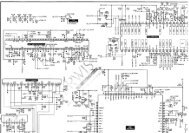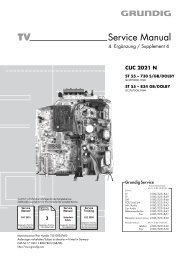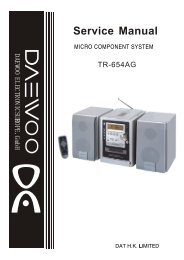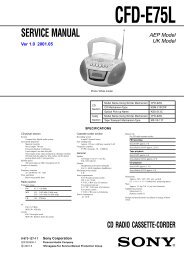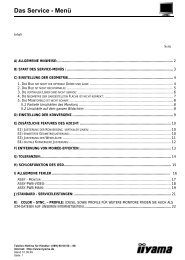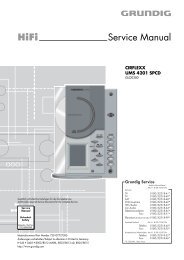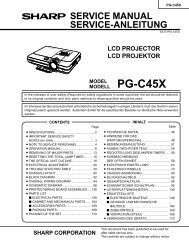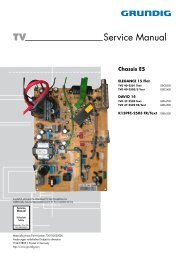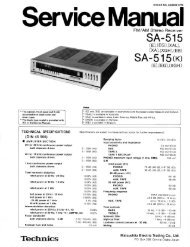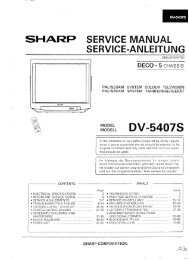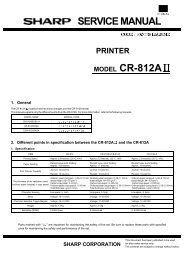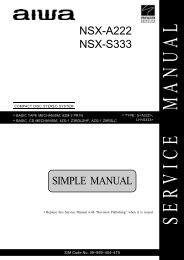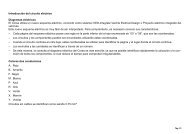LCD TV SERVICE MANUAL - diagramas.diagram...
LCD TV SERVICE MANUAL - diagramas.diagram...
LCD TV SERVICE MANUAL - diagramas.diagram...
Create successful ePaper yourself
Turn your PDF publications into a flip-book with our unique Google optimized e-Paper software.
IC Remove/Replacement<br />
Some chassis circuit boards have slotted holes (oblong) through<br />
which the IC leads are inserted and then bent flat against the<br />
circuit foil. When holes are the slotted type, the following technique<br />
should be used to remove and replace the IC. When working with<br />
boards using the familiar round hole, use the standard technique<br />
as outlined in paragraphs 5 and 6 above.<br />
Removal<br />
1. Desolder and straighten each IC lead in one operation by gently<br />
prying up on the lead with the soldering iron tip as the solder<br />
melts.<br />
2. Draw away the melted solder with an anti-static suction-type<br />
solder removal device (or with solder braid) before removing the<br />
IC.<br />
Replacement<br />
1. Carefully insert the replacement IC in the circuit board.<br />
2. Carefully bend each IC lead against the circuit foil pad and<br />
solder it.<br />
3. Clean the soldered areas with a small wire-bristle brush.<br />
(It is not necessary to reapply acrylic coating to the areas).<br />
"Small-Signal" Discrete Transistor<br />
Removal/Replacement<br />
1. Remove the defective transistor by clipping its leads as close as<br />
possible to the component body.<br />
2. Bend into a "U" shape the end of each of three leads remaining<br />
on the circuit board.<br />
3. Bend into a "U" shape the replacement transistor leads.<br />
4. Connect the replacement transistor leads to the corresponding<br />
leads extending from the circuit board and crimp the "U" with<br />
long nose pliers to insure metal to metal contact then solder<br />
each connection.<br />
Power Output, Transistor Device<br />
Removal/Replacement<br />
1. Heat and remove all solder from around the transistor leads.<br />
2. Remove the heat sink mounting screw (if so equipped).<br />
3. Carefully remove the transistor from the heat sink of the circuit<br />
board.<br />
4. Insert new transistor in the circuit board.<br />
5. Solder each transistor lead, and clip off excess lead.<br />
6. Replace heat sink.<br />
Diode Removal/Replacement<br />
1. Remove defective diode by clipping its leads as close as<br />
possible to diode body.<br />
2. Bend the two remaining leads perpendicular y to the circuit<br />
board.<br />
3. Observing diode polarity, wrap each lead of the new diode<br />
around the corresponding lead on the circuit board.<br />
4. Securely crimp each connection and solder it.<br />
5. Inspect (on the circuit board copper side) the solder joints of<br />
the two "original" leads. If they are not shiny, reheat them and if<br />
necessary, apply additional solder.<br />
Fuse and Conventional Resistor<br />
Removal/Replacement<br />
1. Clip each fuse or resistor lead at top of the circuit board hollow<br />
stake.<br />
2. Securely crimp the leads of replacement component around<br />
notch at stake top.<br />
3. Solder the connections.<br />
CAUTION: Maintain original spacing between the replaced<br />
component and adjacent components and the circuit board to<br />
prevent excessive component temperatures.<br />
Copyright © 2007 LG Electronics. Inc. All right reserved.<br />
Only for training and service purposes<br />
- 5 -<br />
Circuit Board Foil Repair<br />
Excessive heat applied to the copper foil of any printed circuit<br />
board will weaken the adhesive that bonds the foil to the circuit<br />
board causing the foil to separate from or "lift-off" the board. The<br />
following guidelines and procedures should be followed whenever<br />
this condition is encountered.<br />
At IC Connections<br />
To repair a defective copper pattern at IC connections use the<br />
following procedure to install a jumper wire on the copper pattern<br />
side of the circuit board. (Use this technique only on IC<br />
connections).<br />
1. Carefully remove the damaged copper pattern with a sharp<br />
knife. (Remove only as much copper as absolutely necessary).<br />
2. carefully scratch away the solder resist and acrylic coating (if<br />
used) from the end of the remaining copper pattern.<br />
3. Bend a small "U" in one end of a small gauge jumper wire and<br />
carefully crimp it around the IC pin. Solder the IC connection.<br />
4. Route the jumper wire along the path of the out-away copper<br />
pattern and let it overlap the previously scraped end of the good<br />
copper pattern. Solder the overlapped area and clip off any<br />
excess jumper wire.<br />
At Other Connections<br />
Use the following technique to repair the defective copper pattern<br />
at connections other than IC Pins. This technique involves the<br />
installation of a jumper wire on the component side of the circuit<br />
board.<br />
1. Remove the defective copper pattern with a sharp knife.<br />
Remove at least 1/4 inch of copper, to ensure that a hazardous<br />
condition will not exist if the jumper wire opens.<br />
2. Trace along the copper pattern from both sides of the pattern<br />
break and locate the nearest component that is directly<br />
connected to the affected copper pattern.<br />
3. Connect insulated 20-gauge jumper wire from the lead of the<br />
nearest component on one side of the pattern break to the lead<br />
of the nearest component on the other side.<br />
Carefully crimp and solder the connections.<br />
CAUTION: Be sure the insulated jumper wire is dressed so the<br />
it does not touch components or sharp edges.<br />
LGE Internal Use Only



